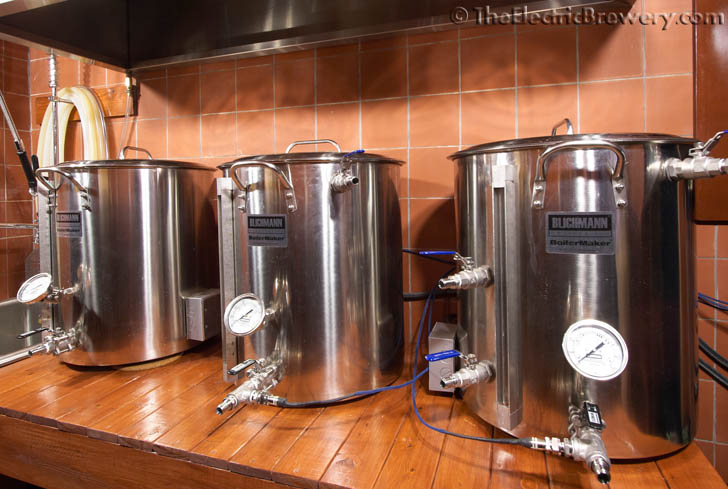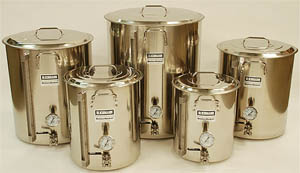Kettles (overview)
 The heart of our brewery consists of three identical 20 gallon Blichmann BoilerMaker kettles.
The heart of our brewery consists of three identical 20 gallon Blichmann BoilerMaker kettles.
These kettles are primarily designed to be heated by natural gas or propane by a burner placed underneath.
We'll describe why we chose to use these kettles and the extra options you'll need to order.
Then in later articles we'll provide details on modifying them for use in our Electric Brewery to convert them into our Hot Liquor Tank, Mash/Lauter Tun, and Boil Kettle.
Blichmann BoilerMaker kettles as shipped:

Boilermaker kettles as installed in the brewery (with some extra parts fitted):
Our Blichmann Boilermaker kettles are all 20 US gallons in size which allows us to brew up to 10 gallons of beer per batch, regardless of style. If pushed, we can get to 13-14 gallons but most times we typically try and aim for 10 gallons of finished beer per batch. This is enough to fill two 5 gallon kegs. Whether it's a 3% ABV (alcohol by volume) light beer or a 12% barleywine, having 20 gallon kettles allows us the flexibility to brew up about 10 gallons of just about anything we can dream up.
If you only intend on brewing 5 gallon batches consider the smaller 10 gallon kettles. If you're thinking that 15 gallons is more your style consider the larger 30 gallon kettles. Want to brew 20 gallons or a full barrel (31 gallons)? The massive 55 gallon kettles are what you'll need. The optional Blichmann 55 Gallon BoilerMaker Extensions may be added to the 55 gallon kettles to increase capacity to 100 gallons for a 2 barrel nanobrewery.
 Not sure what size is right for you? Keep this in mind: The amount of time it takes to brew is (generally speaking) the same regardless of batch size. It takes about 5-8 hours from start to the end of cleanup. Most home brewers look for a good balance between how much work is involved, the amount of beer produced, and how long it's going to take to consume. This means that most home brewers stick to producing approximately 10 gallons of finished product per batch. It's the perfect balance between not having to drink the same beer for months on end and getting the most out of the work involved. Even 10 gallons of beer may seem like a lot at first, but once your friends and family find out what you're up to you'll be surprised how fast it disappears! Most brewers who start with smaller 10 gallon kettles end up upgrading.
Not sure what size is right for you? Keep this in mind: The amount of time it takes to brew is (generally speaking) the same regardless of batch size. It takes about 5-8 hours from start to the end of cleanup. Most home brewers look for a good balance between how much work is involved, the amount of beer produced, and how long it's going to take to consume. This means that most home brewers stick to producing approximately 10 gallons of finished product per batch. It's the perfect balance between not having to drink the same beer for months on end and getting the most out of the work involved. Even 10 gallons of beer may seem like a lot at first, but once your friends and family find out what you're up to you'll be surprised how fast it disappears! Most brewers who start with smaller 10 gallon kettles end up upgrading.
For the ultimate in flexibility, we recommend that all three kettles be at least twice the size of the amount of beer you wish to produce. This is to account for the various losses that occur such as evaporation/expansion/foaming during boiling, grain/hop absorption, chilling/fermentation sediment, racking/kettle/hose deadspace, etc.
So why Blichmann kettles? Anyone who's shopped for brew kettles will tell you that there are many options available, from 15 gallon beer kegs (called 'keggles') to standard cooking pots. Blichmann kettles are unique in that they are designed from the ground up specifically for brewing. We find that a lot of thought has gone into these kettles, which results in making brewing easier. To quote the marketing information from Blichmann:
The BoilerMaker is the only brew pot on the market designed from the ground up solely for homebrewing. The height to diameter ratio is the ideal 1:2 to minimize boil off and also prevent boil-overs. The sizes are optimized to blend seamlessly from hot liquor tanks, mash tuns, boil kettles, to fermenters for the common batch sizes of 5/10/20 gallons and 1 barrel (31 gallons). Blichmann Engineering is serious about brewing, and their designs reflect this passion for quality. With innovations like the stepped bottom, button louvered false bottoms, and snap-in dip tube; to subtle features like orienting the handles to make carrying easier, and a convenient place to rest the lid, you'll find the BoilerMaker line of brewpots to be a joy to use.
All Blichmann BoilerMaker kettles feature:
- 18 ga 304 stainless steel construction
- Adjustable BrewMometer
- 3-piece stainless ball valve
- Borosilicate glass level gauge (never clouds or scratches) with rugged stainless guard, laser-etched volume graduations, cleaning brush, and clean-out ports
- Snap-in dip tube design installs without tools and drains to within 3/8" of bottom
- Handles oriented to make carrying easier and the lid stores neatly on the pot handle
- Stepped bottom on pot supports mash screen and virtually eliminates sidewall shunting
- Button louver false bottom (hybrid of perforated screen and slotted manifold)
One feature not mentioned is that these kettles do not have a heavy clad bottom: The bottom is the same thickness as the side walls (18 ga). Brewers often cite this as a downside to the Blichmann Boilermaker kettles when they are heated with a typical propane or natural gas burner placed underneath. We often hear brewers mention that this thin bottom will lead to scorching the beer as it doesn't disperse the heat evenly. This is not true.
With typical cooking pots you want a heavy clad bottom to help disperse the heat and avoid scorching as often the liquid you're heating/boiling is much thicker (ex: spaghetti sauce) and does not move through convection. When boiling very thin liquids like wort (the sugary water that eventually becomes beer), this is a non-issue as the wort is in constant movement. In our all electric setup the thinner bottom means that the kettles weigh less which in turn reduces the cost. They are also much easier to move around when cleaning than a typical large cooking pot.
Why three kettles?
Three kettles are used in our Electric Brewery. Each performs a unique function:
- Hot Liquor Tank (HLT): Used to heat water for the brewing session. The water we use is 'strike' water for soaking the grain and 'sparge' water for rinsing the grain.
- Mash/Lauter Tun (MLT): Used to soak (mash) the grain in the strike water to release malt sugars. The same kettle is then used to filter (lauter) the malt sugar solution from the grain. Like most small scale brewers we use one kettle to perform both mashing and lautering hence the name 'Mash/Lauter Tun'.
- Boil Kettle (BK): Used to boil the malt sugar solution with hops for seasoning. Before hops are added the malt sugar solution is called 'sweet wort'. After it is simply called 'wort'. (It's not considered 'beer' until later when yeast has been added and has converted the sugars into alcohol).
Going weldless
Blichmann kettles are 100% weldless meaning that there are no threaded screw-on fittings and none of the parts are welded on. The BrewMometer, level gauge, and ball valve are all simply held in place with washers, nuts, and high temperature silicone o-rings. Some feel that weldless means you'll end up with poorly fitted, lose, or leaky connections. Not true. When done right weldless connections will be tight fitting, never leak, never require any adjustments, and be perfectly safe. The stigma of weldless likely comes from the fact that most third party weldless add-ons we know of do not create a tight fitting connection and do require special care when installing or they will leak. Figure 2 from the BoilerMaker manual shows how Blichmann was able to achieve tight and leak-free weldless connections using the BrewMometer as an example (see picture below).
Blichmann weldless BrewMometer:
To seal the kettle from the outside, Blichmann uses a high temperature food grade silicone o-ring fitted inside a stainless steel washer. The washer is the key differentiator between how Blichmann does weldless and how other third party kits do weldless. Most third party weldless kits do not include a washer so the component that is connected to your kettle ends up simply resting against the o-ring and tends to move around when pushed/pulled. These kits always warn about over tightening as it will compress the o-ring and make it bulge, which then causes the setup to leak. Definitely not an ideal solution, especially with items such as ball valves, which tend to get pushed and pulled a fair bit.
Blichmann carefully selected the size of the o-ring and washer such that the o-ring is slightly thicker than the washer. This allows the nut to be tightened down completely, ensuring that the external component does not move at all and still allows the o-ring to create an excellent seal.
Later on in our instructions you'll see how we've applied this same Blichmann weldless principle to attach extra components to our kettles. The result is an extremely tight fit with zero leaks. We'll provide you with all of the washer and o-ring specifications so that you can do the same yourself without having to guess or choose parts by trial and error.






